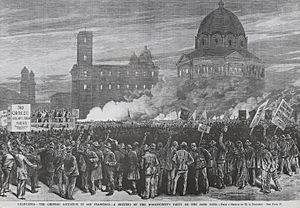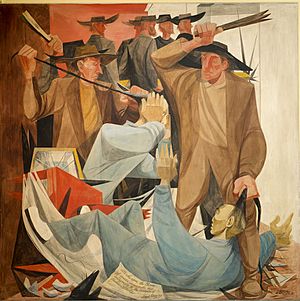San Francisco riot of 1877 facts for kids
Quick facts for kids 1877 San Francisco riots |
|
|---|---|

An illustration from 1880 showing a meeting of the Workingmen's Party of California. They were protesting against Chinese immigrants near San Francisco City Hall.
|
|
| Location | San Francisco, California, U.S. |
| Date | July 23, 1877- July 25, 1877 |
|
Attack type
|
Riot, pogrom |
| Deaths | 4 |
| Victims | Chinese community of San Francisco |
| Assailants | White mobs |
| Motive | Sinophobia |
The San Francisco riot of 1877 was a terrible three-day event. It was a violent attack, also called a pogrom, against Chinese immigrants. This happened in San Francisco, California, led by many white people living in the city. The violence started on the evening of July 23 and lasted until the night of July 25, 1877.
This ethnic violence swept through Chinatown. Four people died, and Chinese immigrants lost over $100,000 worth of their property. This was a huge amount of money back then.
Contents
Why the Riots Happened
For many years, there was growing competition between Chinese and white workers. This started in mining and then spread to other jobs in the 1850s.
Historian Theodore Hittell wrote about this time. He said Chinese workers were usually peaceful and very hardworking. But they were also very careful with their money. They spent little of their earnings, mostly on basic needs. They often bought things from merchants of their own nationality.
This made some people upset. They felt the Chinese workers were not helping the wider economy. Over time, Chinese workers started taking on jobs that white workers also wanted. They worked as servants and laborers. They also opened laundries and worked in different trades. They earned money in ways that some felt should have gone to white workers.
Many Chinese immigrants first came to America to build the First Transcontinental Railroad. After it was finished in 1869, they needed new jobs. In San Francisco, Chinese workers were often hired for less money than white workers. This made them easy targets for blame when times were tough.
Economic Troubles Lead to Unrest
From 1873 through the late 1870s, a serious economic crisis hit the United States. This period is known as the Long Depression. Many people in the eastern U.S. lost their jobs. They decided to move west to try and start over.
Between 1873 and 1875, about 150,000 workers moved to California. Many settled in San Francisco, the state's biggest city. San Francisco had already seen ups and downs. There was a boom after the Gold Rush in the 1850s, then a bust. Another boom happened in the 1870s with the Comstock Lode mining, followed by another bust.
By 1877, the economic depression reached the West Coast. San Francisco's unemployment rate shot up. About 20% of adult men were out of work. There was no government help for unemployed workers. People were very unhappy and frustrated.
San Francisco had about 200,000 residents. Chinese people made up about 10% of the population. White and Chinese workers often competed for the same jobs. Chinese labor was much cheaper, which added to the tension.
What Happened After the Riots?
The end of the July 1877 San Francisco riot did not stop anti-Chinese feelings. Instead, it was just the beginning. One person who helped stop the riot was Denis Kearney. He was an Irish wagon driver. The events of July 1877 pulled him into politics.
Kearney first tried to join the Workingmen's Party. But they turned him down. This was because he openly said that he thought working-class people were "lazy." Since he couldn't join that party, Kearney started his own group. It was called the Workingmen's Trade and Labor Union of San Francisco. Their main saying was "The Chinamen Must Go!"
In October 1877, this group changed its name. It became the Workingmen's Party of California. Kearney became its president. This new party kept its strong anti-Chinese focus and slogans.
Anti-Chinese feelings spread across the United States. This led to a major law being passed in 1882. It was called the Chinese Exclusion Act. This law effectively stopped Chinese workers from coming into the country.
In Media
- Anton Refregier painted a mural called "The Sand Lot Riots of 1870." It is also known as "Beating the Chinese." This painting is part of a series of 27 murals. They are in the Rincon Annex Post Office and are called History of San Francisco. The painting shows Chinese immigrants being beaten by Irish workers. The Chinese were accused of taking jobs.
- A made-up version of the riots was shown in the TV show Warrior. It was in the ninth episode of season 2, first shown in 2020.



